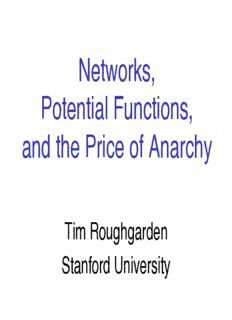
Networks, Potential Functions, and the Price of Anarchy PDF
Preview Networks, Potential Functions, and the Price of Anarchy
Networks, Potential Functions, and the Price of Anarchy Tim Roughgarden Stanford University PRICE OF ANARCHY (1G) 2 Pigou's Example Example: one unit of traffic wants to go from s to t cost depends on congestion c(x)=x s t c(x)=1 no congestion effects Question: what will selfish network users do? • assume everyone wants smallest-possible cost • [Pigou 1920] 3 Motivating Example Claim: all traffic will take the top link. Flow = 1- c(x)=x Є s t c(x)=1 this flow is envious! Flow = Є Reason: • Є > 0 traffic on bottom is envious • Є = 0 equilibrium – all traffic incurs one unit of cost 4 Can We Do Better? Consider instead: traffic split equally ½ c(x)=x Flow = s t c(x)=1 ½ Flow = Improvement: • half of traffic has cost 1 (same as before) • half of traffic has cost ½ (much improved!) 5 Braess’s Paradox Initial Network: ½ ½ x 1 s t ½ ½ x 1 Cost = 1.5 6 Braess’s Paradox Initial Network: Augmented Network: ½ ½ ½ ½ x x 1 1 s t s 0 t ½ ½ ½ ½ x x 1 1 Cost = 1.5 Now what? 7 Braess’s Paradox Initial Network: Augmented Network: ½ ½ x x 1 1 s t s 0 t ½ ½ 1 x 1 x Cost = 1.5 Cost = 2 8 Braess’s Paradox Initial Network: Augmented Network: ½ ½ x x 1 1 s t s 0 t ½ ½ 1 x 1 x Cost = 1.5 Cost = 2 All traffic incurs more cost! [Braess 68] • also has physical analogs [Cohen/Horowitz 91] 9 High-Level Overview Motivation: equilibria of noncooperative network games typically inefficient • e.g., Pigou's example + Braess's Paradox • don't optimize natural objective functions Price of anarchy: quantify inefficiency with respect to an objective function Our goal: when is the price of anarchy small? – when does competition approximate cooperation? – benefit of centralized control is small 10
Description: